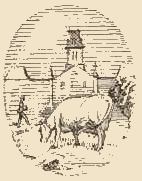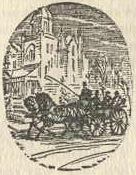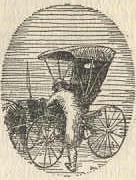Resource Center
On-Line Library
T H E P R A I R I E C A P
I T A L
![]()

The University.
THE
University was another instance of the paper foundations on which
it rested appearing more substantial than the material
under-pinning. Soon after the first and only building was built
(the old University Hall) it showed the defects of its kind and of
its time. The building was condemned. The condemnation was
withdrawn. Then the original foundation was replaced. The town
folk of Lincoln advanced the money and never were repaid.
The University found as well that the
foundations of its scholastic structure were faulty. It was ready
to give higher learning. But there were few students qualified to
receive it. Between the public schools as they then were, and the
University was a gap. This was supplied by the organization of the
two year Preparatory School. As high schools in-
T H E P R A I R I E C A P
I T A L
![]()
creased in number and efficiency they gradually assumed the
task of preparing students for university work. But for many years
the University was compelled to do this work. This made the time
to secure a degree six years, and with one or two exceptions all
the early classes had been in residence that long before they
graduated. Judge Dales and Judge Snell were the first to receive
A. B. degrees. The classes of 1877 and later were the first to
serve the full time. Snell and Dales got through sooner because
they had better preparation to start with.
The University had to contend not only with the
poverty of the pioneer state, but suffered from a divided public
opinion. For many years it could be shown by figures (and was)
that the state could save money by sending all its university
students to the best colleges of the east and paying their way
while there. It was said that the University never could be better
than third rate. These arguments appealed to many. But there have
always been enough Nebraskans who wanted their own University to
keep the spark of life in its bosom, though there have been times
when that spark was nearly extinguished.
The University of the early days was wholly
different from the institution of 1930. There were no swarming
thousands of students. It was ten years after its beginning before
the number passed two hundred. There was no beautiful campus, but
an open common where sometimes the village cows
T H E P R A I R I E C A P
I T A L
![]()
peacefully grazed. There was but the one original building.
There were no fraternities. The whole social side of University
life was to be found in the Friday night meetings of the literary
societies. There were no games, no cheer leaders, no songs, no
yells. Lecture rooms and library were meagerly equipped. Students
were so few that the upper floor was used as a dormitory.
But the University had men on its small faculty
who had the true vision of the higher education. Many of them
became eminent in later life. They have made their great
contributions to art, to science, and literature. Benton,
Fairfield, Manatt, Sherman, Bessey, MacMillan, Hitchcock, Bennett,
Duke, Woodbury, to name but a part of them, are great and honored
names in the history of the state. The few students in their small
classes had the great advantage of close and intimate contact with
these great teachers, a contact which present day crowded class
rooms makes impossible. The result has been a culture and an
inspiration, that no wealth of material equipment can of itself
supply.
T H E P R A I R I E C A P
I T A L
![]()

Society
HOSPITALITY is the cardinal virtue of the frontier. The pioneers of the frontier Prairie Capital were young. Both facts combined from the very beginning to make the social function prominent. The starting of a new house was the signal for a party. Its completion meant a house warming. Everybody knew everybody else. Formality was impossible. There was a very definite show of animal spirits. Of course, they all put on their glad rags and exhibited their party manners. But there was no pretense of social exclusiveness. Groups, of course, developed but their basis was not that of wealth or occupation. Butcher, baker and candlestick maker and their "ladies" were all eligible. It was much later than the early days that a military officer, assigned to the University as Commandant. and accustomed to the
T H E P R A I R I E C A P
I T A L
![]()
arbitrary eligibilities of an effete East, expressed a
plaintive surprise at meeting his tailor at the swellest party of
the season. The lady in whom he confided was amused enough to
repeat the remark. When the Captain was asked as to the accuracy
of the report he made himself famous by the answer, "Whatever the
lady said I said, I said."
The amusements of the adults would seem slow to
the children now. They played games. They made charades. They
danced the Virginia Reel and the Lancers. When there was room and
the floor was fit they danced the polka and the schottische, and
the more expert the waltz. When "refreshments" were served they
were substantial. The "festive board" always "groaned." Now and
then some patriarch of thirty or so, would celebrate his tin
wedding. His friends came bearing gifts, all of tin. There would
be a great clamor of tin horns and of beaten dish pans. The paper
next day would report the event in full as a '"joyful occasion."
The report was accurate. The scribe had been there in person and
had made his share of the noise. Not till much later did the paper
describe the ladies' dresses. There was then no need. Everybody
knew them. For mostly the ladies had but one party dress at a time
and a long time at that. If it was a black silk it was adequate
for all time. They had a good time. Nobody yet had taken the fun
out of function.
New Years Day was the big day in the social
calendar. The ladies, usually in groups, kept open
T H E P R A I R I E C A P
I T A L
![]()
house to all callers. The men in all their finery (and it was
the day of the Prince Albert and the fancy waistcoat) also in
groups, chartered Gran Ensign's sea-going-hacks and made the
rounds. The popularity of the custom grew until one hectic day
that left all the contestants flat footed from so much standing
around. It disappeared like Mah Jong in 1925 or like thumb nail
golf in 1931. But as an informal reunion Mr. and Mrs. A. J. Sawyer
held a New Year's party each year that was the delight of those
who enjoyed their charming hospitality.
With the growth of the town and with the great
increase of wealth, society became more complex. Many of the older
mansions of the city date from the 80's and were the centers of
social interest. Innumerable clubs appeared. Functions became more
elaborate and formal. But in the Prairie Capital society has never
become an end in itself. It still retains a large share of the
open, generous cordiality of the early days. And the men at least,
still put on their party duds under protest.
T H E P R A I R I E C A P
I T A L
![]()

Doctors
THE doctors of the village days in the Prairie Capital were truly prominent citizens. They were marked and set apart from other men. The doctor was distinguished by his clothes which were a mean between the clerical and the legal. His name was on a sign at his residence. His office was in or above a well known drug store. He advertised in the papers. True, he violated no professional code in his published "card." Before the telephone directory became the guide to all offices, the doctor's "ad" merely told the public where to find the doctor. He was to be known by a faint and agreeable scent of drugs that accompanied him; drugs that he mixed and administered at the bedside. A further mark was the black case of instruments and medicines that he always carried.
T H E P R A I R I E C A P
I T A L
![]()
The doctor was a general practitioner--a
family doctor--a country doctor. He had to be, to make a living.
The people were young and discouragingly healthy. A lot of
diseases that afflict the children of men today they never had.
The minor ones they had they took care of with the aid of grandma
and the neighbors. They had to be real sick to call in the doctor.
It is no wonder he traveled far and often late.
When he was called he was a tower of strength.
had the confidence, the friendship and the love of the people he
served. And he deserved them. No call was too far or too late for
him to make. No sod shanty on a frontier homestead was too poor
for him to visit, often in night and storm. He had almost none of
the aids the modern doctor enjoys.
There were no trained nurses, no hospitals, no
serums, vaccines, anti-toxins. Alone he fought his good fight.
Often he had to improvise from the meager household equipment of a
frontier home, the appliances of the sick room. And when all was
done, his modest fees were nearly always booked. Sometimes some of
them were paid. None of the pioneer doctors of the prairie grew
rich from professional earnings. The names of Doctor Latta, Doctor
Beachley, Doctor Robbins (to name but a few of them) are still
held in affectionate memory by many. Of all who practiced in
Lincoln before 1880, Doctor Mitchell alone remains. This must make
him the Dean of the profession in the Prairie Capital.
T H E P R A I R I E C A P
I T A L
![]()
It would be gravely unjust to leave the impression that the pioneer medicine man was unqualified. He was fully abreast of the science of the day. That science was not what it is now, and by comparisons his knowledge was meager. But it was sound and his skill and ingenuity made it surprisingly adequate. He was young, though the gravity of his professional manner sometimes concealed the fact. He had come to the young state for the same motives and in the same spirit that moved most of his fellows. He made his place in the community and he stayed in it. Nearly all them ended their lives in it. And fully deserved the high esteem in which the community held them.